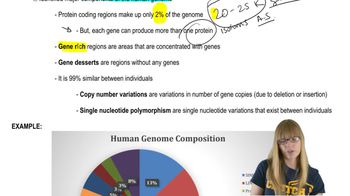Table of contents
- 1. Introduction to Genetics51m
- 2. Mendel's Laws of Inheritance3h 37m
- 3. Extensions to Mendelian Inheritance2h 41m
- 4. Genetic Mapping and Linkage2h 28m
- 5. Genetics of Bacteria and Viruses1h 21m
- 6. Chromosomal Variation1h 48m
- 7. DNA and Chromosome Structure56m
- 8. DNA Replication1h 10m
- 9. Mitosis and Meiosis1h 34m
- 10. Transcription1h 0m
- 11. Translation58m
- 12. Gene Regulation in Prokaryotes1h 19m
- 13. Gene Regulation in Eukaryotes44m
- 14. Genetic Control of Development44m
- 15. Genomes and Genomics1h 50m
- 16. Transposable Elements47m
- 17. Mutation, Repair, and Recombination1h 6m
- 18. Molecular Genetic Tools19m
- 19. Cancer Genetics29m
- 20. Quantitative Genetics1h 26m
- 21. Population Genetics50m
- 22. Evolutionary Genetics29m
16. Transposable Elements
Transposable Elements in Eukaryotes
Problem 30
Textbook Question
It has been noted that most transposons in humans and other organisms are located in noncoding regions of the genome—regions such as introns, pseudogenes, and stretches of particular types of repetitive DNA. There are several ways to interpret this observation. Describe two possible interpretations. Which interpretation do you favor? Why?
 Verified step by step guidance
Verified step by step guidance1
Step 1: Understand what transposons are—segments of DNA that can move around within the genome, often called 'jumping genes.' Recognize that their presence in noncoding regions means they are found in parts of the DNA that do not code for proteins, such as introns, pseudogenes, and repetitive DNA sequences.
Step 2: Consider the first interpretation: transposons preferentially insert into noncoding regions because these areas are less likely to disrupt essential genes, thus minimizing harmful effects on the organism. This suggests a selective pressure that favors transposon insertions in 'safe' genomic regions.
Step 3: Consider the second interpretation: transposons may insert randomly throughout the genome, but those that land in coding regions are often deleterious and removed by natural selection, leaving a higher observed frequency in noncoding regions over time.
Step 4: Evaluate which interpretation is more plausible by thinking about evolutionary mechanisms—whether transposons have insertion site preferences or if natural selection shapes their distribution by eliminating harmful insertions.
Step 5: Formulate your favored interpretation by weighing evidence such as known insertion mechanisms of transposons and the role of natural selection, and explain your reasoning clearly, emphasizing the balance between insertion bias and selective pressures.
 Verified video answer for a similar problem:
Verified video answer for a similar problem:This video solution was recommended by our tutors as helpful for the problem above
Video duration:
1mPlay a video:
Was this helpful?
Key Concepts
Here are the essential concepts you must grasp in order to answer the question correctly.
Transposons and Their Genomic Locations
Transposons are DNA sequences that can move within the genome, often called 'jumping genes.' In many organisms, including humans, they are frequently found in noncoding regions like introns, pseudogenes, and repetitive DNA. Their location affects their potential impact on gene function and genome stability.
Recommended video:
Guided course

Functional Genomics
Noncoding DNA and Its Functional Significance
Noncoding DNA includes regions that do not code for proteins, such as introns, pseudogenes, and repetitive sequences. While once considered 'junk,' many noncoding regions have regulatory or structural roles, influencing gene expression and genome organization.
Recommended video:
Guided course

Functional Genomics
Interpretations of Transposon Distribution
The presence of transposons mainly in noncoding regions can be interpreted as either a result of selective pressure removing harmful insertions from coding regions or as a preference for insertion into less harmful genomic areas. Understanding these interpretations helps explain genome evolution and stability.
Recommended video:
Guided course

Human Genome Composition

 3:21m
3:21mWatch next
Master Eukaryotic Transposable Elements with a bite sized video explanation from Kylia
Start learningRelated Videos
Related Practice
Textbook Question
Compare DNA transposons and retrotransposons. What properties do they share?
1081
views
